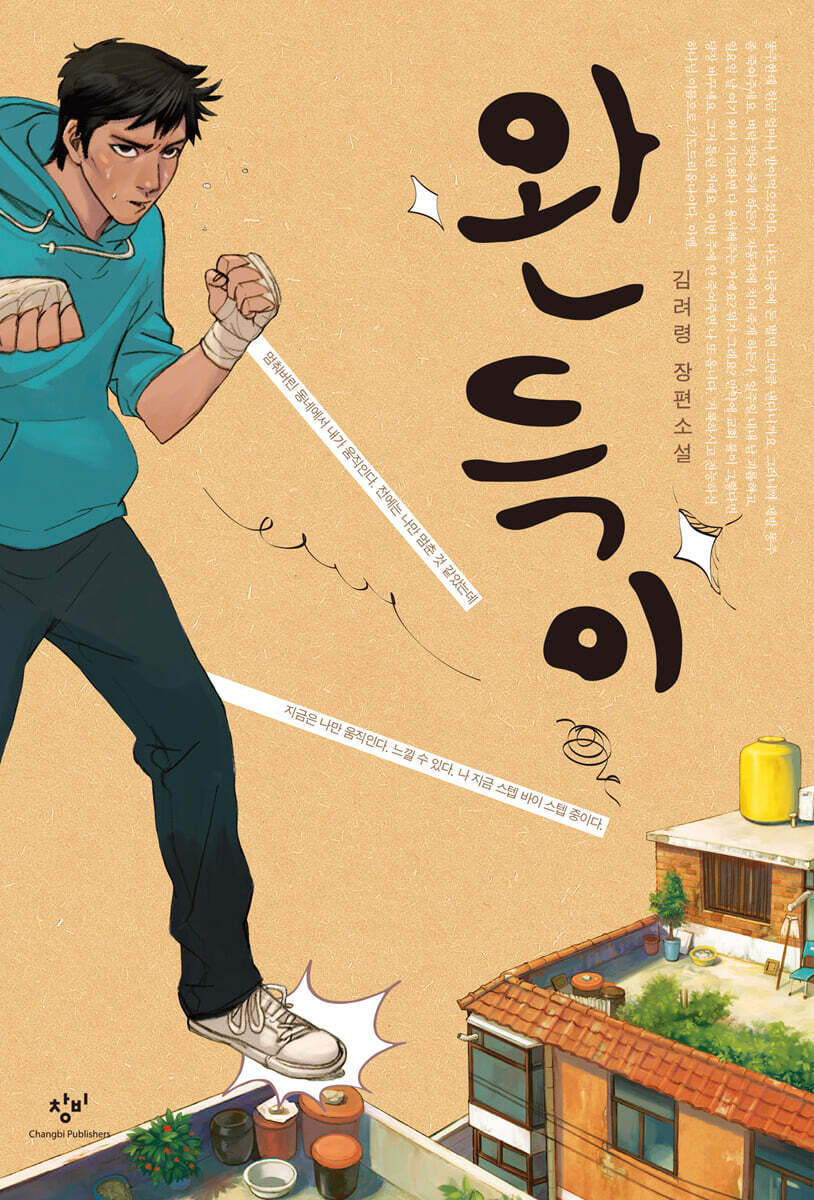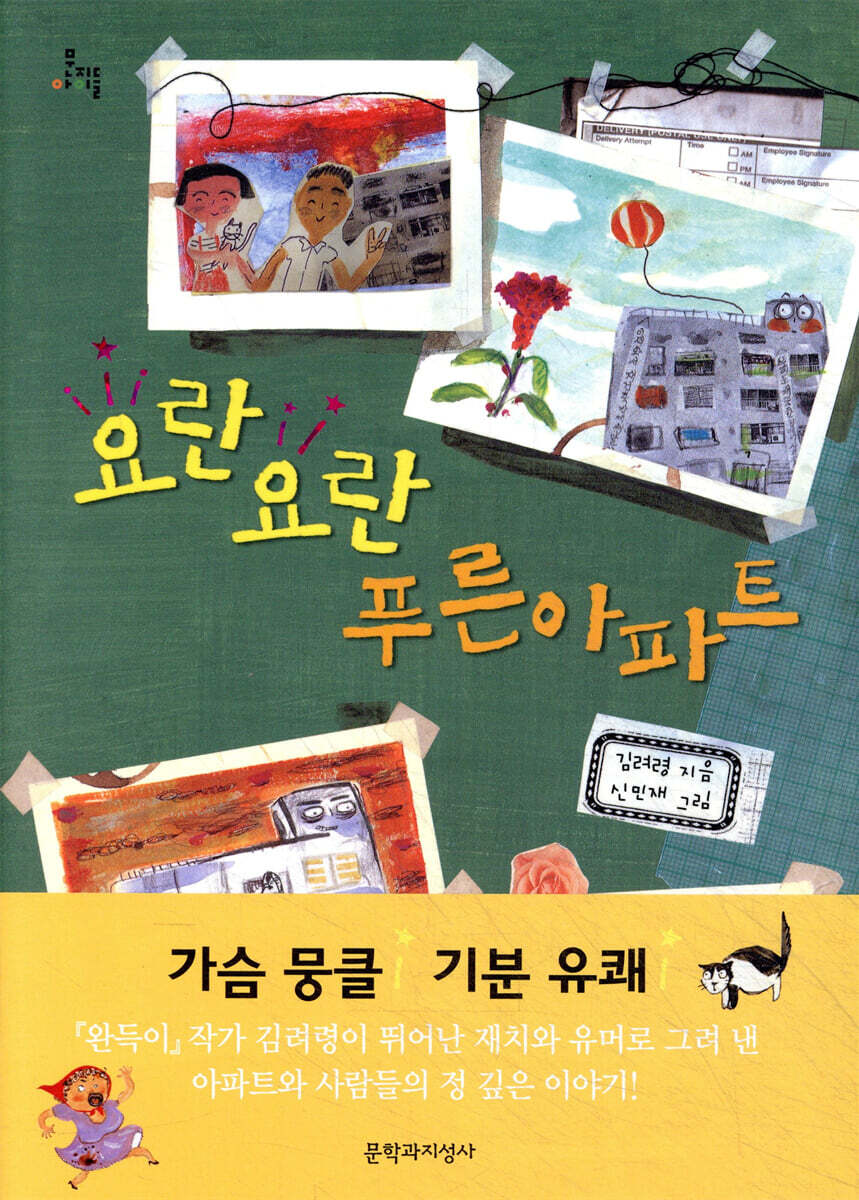Kim Ryeoryeong (born 1971) is a South Korean writer.
Life
Kim Ryeoryeong was born in Seoul in 1971. Kim made her literary debut in 2007 winning three major literary awards in the same year: the Ma Hae-song Literary Award for Gieogeul gajyeoon ai (기억을 가져온 아이 The Child Who Brought Memories); the Munhak Dongne Children's Literature Prize for Nae gaseume haemaga sanda (내 가슴에 해마가 산다 A Seahorse Lives in My Heart), and the Changbi Prize for Young Adult Fiction for Wandeugi (완득이 Wandeuk). She studied creative writing at Seoul Institute of the Arts with the aim of writing adult fiction, but pivoted to children's fiction upon the suggestion of her professor, the children's writer Hwang Sun-mi.
Kim grew up in Seoul with her maternal grandmother, and in Daejeon with her paternal great-grandmother, listening to their old stories. As a high school student, Kim and her friends were smitten by Michelle Yeoh's performance in Yes, Madam and immediately signed up to learn kung fu. Kim lasted about a year, but the experience came in handy when writing Wandeugi, which includes a kickboxing gym as part of the background.
Kim has published over a dozen works including the novels Neoreul bwasseo (너를 봤어 I Saw You), Gasi gobaek (가시 고백 Thorny Confession), Teureongkeu (트렁크 Trunk), Peulloting aillaendeu (플로팅 아일랜드 Floating Island), Iljuil (일주일 One Wek), and the short story collection Syangdeullie (샹들리에 Chandelier).
Writing
Kim's characters are extremely typical, ordinary neighbors one might run into in anywhere, but on taking a closer look they reveal hard-earned scars. Their stories deal with often difficult situations, but the author shies away from explicit criticism, preferring to treat everyone fairly. Nae gaseume haemaga sanda exposes the way in which adoptive parents and their child see each other, while Gieogeul gajyeoon ai examines the reappearance of forgotten memories.
Kim has said of her writing, "People often wonder which of my characters is me. If my readers want to believe that the characters represent real people, I tell them to do so. My characters are both me and those with whom I have come into contact. I always use people who have brought me down. But when I feature these characters I do so not to accuse them but to capture their essence, to confess to them. 'I didn't really know you' is what I want to say. You were right.' It is my way of thanking them. It is also a way of keeping their destiny a secret. As a writer, I deal with things not only on the surface but under it. My job is to dig up those places that have barely been discovered. I look not only to look into the eyes of my characters but to look beyond them into the unseen."[1]
Wandeugi, Kim's best-known work to date, tells the story of a seventeen year-old boy who is abandoned by his mother and lives with his disabled father and uncle in a run-down part of town. Left alone to his own devices most of the time, Wandeuk struggles at school, but never loses a fistfight. With the encouragement of his teacher, he eventually channels his anger into kickboxing and is able to reunite with his mother in a mature way. The novel went on to sell more than 700,000 copies and was made into a successful film in 2011, titled Punch for its foreign release. Her next novel, Uahan geojinmal (우아한 거짓말 Elegant Lies), was adapted into the 2014 film Thread of Lies directed by Lee Han, the same director behind Punch.
References
[1] Korea Literature Now. Oct 19, 2014. https://kln.or.kr/frames/interviewsView.do?bbsIdx=538
Su obra se centra en general en temas de la adolescencia. Los personajes de Kim Ryeo-ryeong son gente corriente, personas comunes con las que podemos toparnos en cualquier callejuela, pero vistos más de cerca, son seres que esconden profundas y duras cicatrices bajo la máscara de una sonrisa. De todos modos, la autora siempre parece decirnos que aún en la vida más triste y trágica, brilla de a ratos el sol.
Ha ganado numerosos premios, incluidos el Premio Munhak Dogne de Literatura infantil en 2007 por Un caballito de mar vive en mi corazón, el Premio Literario Ma Hae-song en 2007 por El niño que trajo los recuerdos y el Premio Changbi en 2007 por Wandeuk.4
Wandeuk fue un éxito editorial inmediato5 y fue declarada la mejor novela del año en una encuesta hecha por la librería online Aladdin, el portal de Internet egloos y allblog.6 Vendió más de 700.000 ejemplares y fue adaptado al cine en 2011 con el título en inglés de Punch.7 Otra novela, Mentiras elegantes (2009), fue llevada al cine en 2014 con el mismo título por el director Lee Han, el mismo de Punch.8 .
Son travail se concentre surtout sur l'univers de l'adolescence. Ses personnages sont des personnes typiques en apparence, mais à y regarder de plus près, ils comportent en eux de profondes blessures. La source de ces blessures est cachée le plus souvent derrière un sourire de circonstance. L'auteure souhaite, avant tout, délivrer un message d'optimisme et d'espoir car il n'existe, selon elle, pas de situations irrémédiables. Elle délivre également une critique envers les personnes cherchant à se reposer sur leurs propres biens, prêtes à tromper les autres pour arriver à leurs fins1. Elle a remporté plusieurs prix littéraires dont le prix de la littérature de jeunesse Munhakdongne en 2007 pour Un hippocampe vit dans mon cœur (Nae gaseume haemaga sanda) le prix littéraire Ma Hae-song pour L'enfant qui a apporté la mémoire (Gi-eogeul gajeo-on a-i), et le prix littéraire Changbi (Création et Critique) pour Wandeuk3.
Son roman Wandeuk a été adapté en film sous le titre Punch. En 2014, son roman Élégants mensonges (U-ahan geojitmal) est également adapté en film Thread of Lies (Tissu de mensonges) par le même réalisateur, Lee Han4.
Kim Ryŏ-ryŏng wurde 1971 in Seoul geboren. Sie wuchs sowohl bei ihrer Großmutter mütterlicherseits wie auch bei ihrer Urgroßmutter väterlicherseits in Seoul bzw. Taejŏn auf, was sie stark prägte. In ihrer Kindheit, die sie in einem kleinen Dorf verbrachte, war es ihr Traum, Lehrerin oder Polizistin zu werden, da sie fasziniert von ihrer eigenen Lehrerin war, die alles zu wissen schien und alles für sie tat. Ihr Wunsch, einmal in einem Polizeiauto zu fahren, war so groß, dass sie einmal sogar so tat, als wüsste sie den Weg nach Hause nicht. Der Polizist auf der Polizeiwache gab Kim und ihren Freundinnen etwas zu essen, hörte sich geduldig ihre Geschichte an und fuhr sie in dem Polizeiwagen nach Hause. Diese spezielle Erfahrung schien Kim zur Darstellung von selbstlosen Erwachsenen als Charaktere zu inspirieren, die vorbehaltlos jungen Menschen Gehör schenken, wie z. B. der Wachmann in Hast du den schon mal gesehen? (그 사람을 본 적이 있나요), Onkel Oh in Die elegante Lüge (우아한 거짓말) und der Mister Direktor in Wandŭk (완득이).
Während ihres Abiturs schaute Kim einen Film aus Hongkong und kurz darauf meldete sie sich mit ihren Freundinnen in einer Kung-Fu-Kampfschule an. Dieser Tick hielt etwa ein Jahr an, jedoch halfen ihr die dort gemachten Erfahrungen ihren Bestseller Wandŭk zu schreiben, welcher unter anderem von einer Kickbox-Schule handelt. Kim stellt in dieser Geschichte das Verhalten und den psychologischen Zustand eines Jugendlichen so realistisch dar, dass einige Leser das Gefühl hatten, im Herzen der Autorin lebe ein siebzehnjähriger Junge. Auch die Tatsache, dass die Freundschaft mit ihren Kameraden aus der Kung-Fu-Schule, welche später Lehrmeister im Kickboxen wurden, anhielt, half ihr beim Schreiben.
Ihr Wunsch war es zwar, Literatur zu studieren, jedoch musste sie erst erwachsen werden, heiraten und zwei Kinder bekommen, bevor sich dieser Wunsch mit über dreißig Jahren erfüllte. Sie besuchte die Abteilung für Kreatives Schreiben des Seouler Instituts für Kunst. Sie startete ihre Karriere als Schriftstellerin zwar relativ spät, schrieb dafür aber umso rückhaltloser. Nachdem sie zwei Kinder auf die Welt gebracht hatte, gab es nichts mehr, was ihr Angst machte, und mit fünfunddreißig konnte sie auch nichts mehr schocken. Kim hatte die Angewohnheit, sich Notizen zu machen, wann immer sie einen eigenartigen Dialog hörte oder jemand traf, der sich auffällig verhielt. Diese Angewohnheit wurde zu einem nützlichen Werkzeug für den späten Start ihrer Karriere. Im Gegensatz zu anderen Kindergeschichten tauchen in ihren Geschichten immer eine große Anzahl von Charakteren auf, die markante und einzigartige Eigenschaften besitzen.
In der Universität begann sie Werke zu verfassen, nachdem sie dort auf die Kinderbuchautorin Hwang Sŏn-mi getroffen war. Sie machte 2006 ihren Abschluss und verfasste im selben Jahr drei Geschichten, für die sie mit Auszeichnungen belohnt wurde.[2]
Tốt nghiệp khoa sáng tác văn nghệ trường Đại học Nghệ thuật Seoul.
Là tác giả được yêu thích không chỉ trên lĩnh vực truyện dành cho thanh thiếu niên mà cả những truyện dành cho người lớn.
Bằng sự vui tươi hóm hỉnh, tính cách nổi bật, những câu chuyện vui hài, tác giả đã nhận được nhiều sự mến mộ của độc giả. Trong các tác phẩm của tác giả, có các truyện “Wandeoky”, “lời nói dối ngọt ngào” đã được dựng thành phim và nhận được sự yêu mến của công chúng.
Những tác phẩm tiêu biểu có: “Wandeoki”, “Lời nói dối ngọt ngào”, “Con cá ngựa sống trong tim tôi”, “Cậu bé mang ký ức trở về”, “Chung cư xanh huyên náo”, “Cậu đã thấy người đó chưa?”, “Tớ thấy cậu rồi nhé” v.v…
김려령(1971~)은 대한민국의 소설가다.
생애
김려령은 1971년에 태어났다. 서울예술대학에서 문예창작을 공부했다. 작가는 2007년 발표한 장편소설 《기억을 가져온 아이》로 제3회 마해송문학상을 받으며 작품 활동을 시작했다. 이후 2008년 출간한 첫 소설집 《완득이》와 《우아한 거짓말》(2009)이 대중들로부터 큰 관심을 받아 베스트셀러는 물론, 영화로도 만들어졌다. 2007년에 제8회 문학동네어린이문학상, 제1회 창비청소년문학상, 제3회 마해송문학상 등 다수의 문학상을 수상했다.
작품 세계
김려령은 대중적인 서사 구성, 생생한 캐릭터, 거침없는 문장으로 소외당하고 상처받은 사람들의 이야기를 들려준다. 작가가 소설의 주제로 삼는 것들은 관념적이거나 이념적인 것이 아니라 일상의 폭력에 희생당하거나 분노를 드러낼 줄 모르는 힘없는 사람들의 이야기다.
《완득이》(2008)는 가난한 집 아들인 주인공 완득이가 세상에 대한 분노를 표출하는 법을 익히고, 어머니를 만나면서 애정을 표현하는 법을 알게 되며 성장해나가는 이야기다. 작가는 현실에서 튀어나온 듯한 생생한 캐릭터와 날렵한 문체로 거침없이 성장하는 주인공의 삶을 보여준다.
장편소설 《트렁크》(2015)는 기발한 상상력과 명쾌한 화법으로 인간관계에서 발생하는 폭력과 사랑을 핍진하게 그려내고 있다. 작가는 대중적인 주제를 다루면서도 폭 넓은 사유와 개성 넘치는 문체로 우리 삶의 깊이를 드러내는 서사를 구축해왔다.
소설집 《샹들리에》(2016)에는 평범한 사람들의 모습으로 폭넓은 공감을 불러일으키는 작품들이 수록되어 있다. 작가는 시시한 일상과 보잘것없는 순간 속에서도 삶을 견뎌내고 있는 인물들을 통해 삶의 의미를 모색하고 공감의 폭을 넓히고 있다.
장편소설 《일주일》(2019)은 성숙한 사랑과 결혼에 대한 작가만의 깊이 시선으로 구성된 이야기다. 작가는 주인공 남녀가 사랑과 상처에 대응하는 모습과 그 과정을 대중적인 서사 구조를 통해 보여주면서, 사랑의 여러 면모를 깊이 있게 다루고 있다. 이를 위해 작가는 힘겨운 일상, 인간에 대한 이해, 결혼 제도 등 흔히 볼 수 있는 주제를 작가만의 감각으로 구현하고 있다.
주요 작품
1) 소설집
《샹들리에》, 창비, 2016.
2) 장편소설
《내 가슴에 해마가 산다》, 문학동네, 2007.
《기억을 가져온 아이》, 문학과지성사, 2007.
《완득이》, 창비, 2008.
《요란 요란 푸른 아파트》, 문학과지성사, 2008.
《우아한 거짓말》, 창비, 2009.
《그 사람을 본 적이 있나요?》, 문학동네, 2011.
《가시고백》, 비룡소, 2012.
《너를 봤어》, 창비, 2013.
《트렁크》, 창비, 2015.
《일주일》, 창비, 2019.
수상 내역
2007년 제1회 창비청소년문학상
2007년 제3회 마해송문학상
2007년 제8회 문학동네어린이문학상 대상





